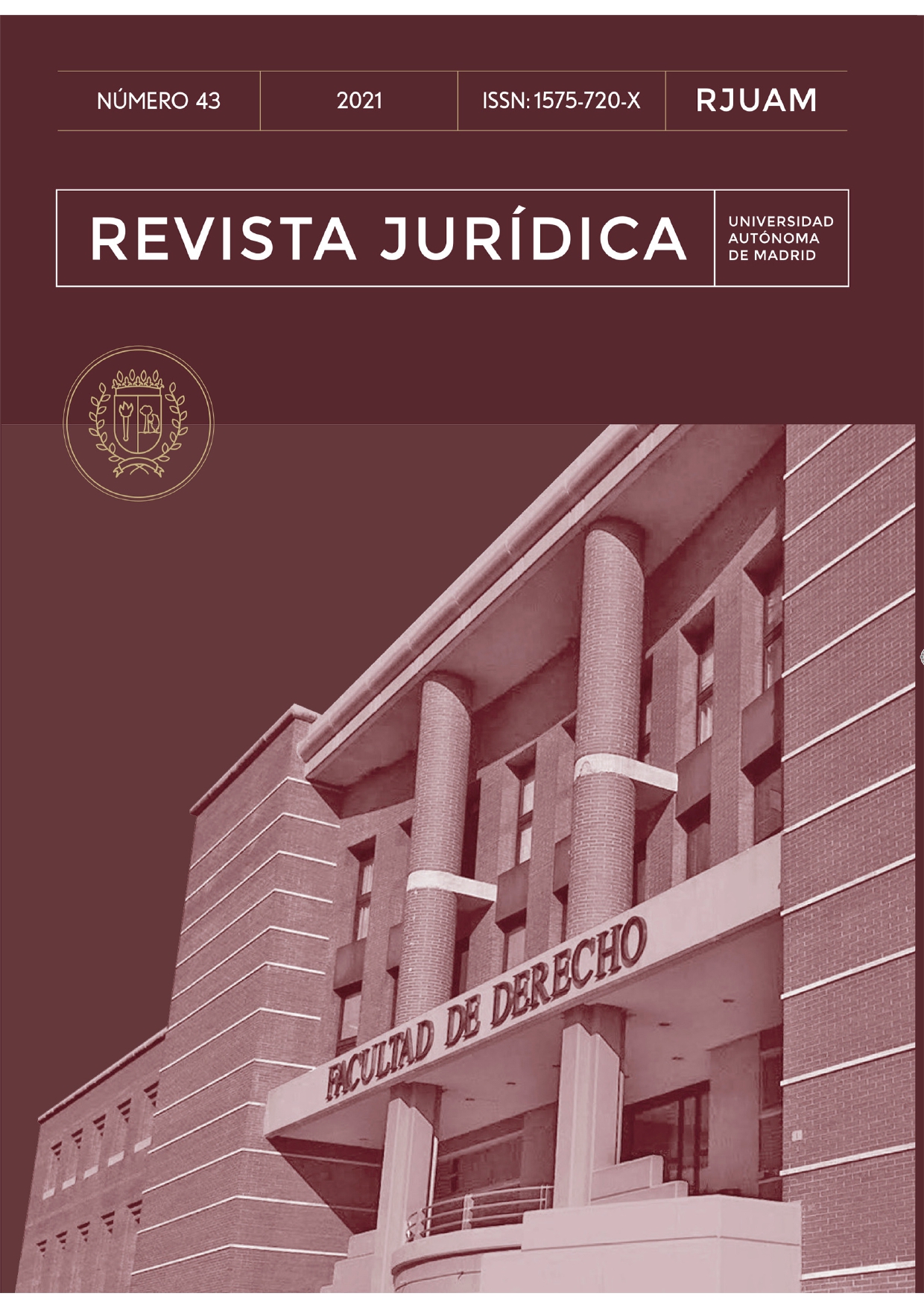Polarisation, partisan preferences, and strategic vote in Spain (2015-2019): approaching to strategic voting in the left-wing spectrum
Keywords:
strategic voting, polarisation, partisan preferences, Spain, eft-wing spectrumCopyright (c) 2021 Revista Jurídica Universidad Autónoma de Madrid

This work is licensed under a Creative Commons Attribution-NonCommercial-NoDerivatives 4.0 International License.
Abstract
This article examines the effect of polarisation on the probability to cast a strategic vote by that segment of the electorate whose first vote choice is a “non-viable” party. To this end, we focus on Spain and on the left-wing spectrum, using the pre-election surveys conducted by the CIS for the 2015, 2016 and 2019 (28A and 10N) general elections. We conclude that polarisation between “viable” parties (PP and PSOE) increases the probability for UP’s and MP’s (“non-viable” parties) supporters to cast a strategic vote in favour of the PSOE, because it also intensifies the affinity that the left-wing voter feels towards their favourite party among the viable ones (PSOE) and dilutes the distance between the affinity he/she feels for UP/MP and for the PSOE. In other words, polarisation in Spain increases the chances of voting tactically for the PSOE because it alters the partisan preferences of the left-wing electorate.
Downloads
References
ABRAMSON, P., ALDRICH, J., PAOLINO, P., y ROHDE, D., «Sophisticated Voting in the 1988 Presidential Primaries», American Political Science Review, vol. 86, 1992, pp. 55-69.
ÁLVAREZ, M., BOEHMKE, F., y NAGLER, J., «Strategic Voting in British Elections», Electoral Studies, vol. 25, 2006, pp. 1-19.
BLAIS, A. y NADEAU, R., «Measuring Strategic Voting: A Two-Step Procedure», Electoral Studies, vol. 15, 1996, pp. 39-52.
BLAIS, A., NADEAU, R. GIDENGIL, E., y NEVITTE, N., «Measuring Strategic Voting in Multiparty Plurality Elections», Electoral Studies, vol. 20, núm. 3, 2001, pp. 343-352.
BOL, D., BLAIS, A., y LABBÉ SAINT VINCENT, S., «Which Matters Most: Party Strategic Entry or Strategic Voting? A Laboratory Experiment». Political Science Research and Methods, vol. 6, 2018, pp. 229-244.
BURDEN, B. C., «Minor Parties and Strategic Voting in Recent U.S. Presidential Elections», Electoral Studies, vol. 24, 2005, pp. 603-618.
CIS, «Macrobarómetro preelectoral de las elecciones generales del 20 de diciembre de 2015. Estudio 3117», 2015. Disponible en: <http://www.cis.es/cis/opencm/ES/1_encuestas/ meses3.jsp>. [Consultado el 31/01/2021].
CIS, «Macrobarómetro preelectoral de las elecciones generales del 26 de junio de 2016. Estudio 3141», 2016. Disponible en: <http://www.cis.es/cis/opencm/ES/1_encuestas/ meses3.jsp>. [Consultado el 31/01/2021].
CIS, «Macrobarómetro preelectoral de las elecciones generales del 28 de abril de 2019. Estudio 3242», 2019a. Disponible en: <http://www.cis.es/cis/opencm/ES/1_encuestas/ meses3.jsp>. [Consultado el 31/01/2021].
CIS, «Macrobarómetro preelectoral de las elecciones generales del 10 de noviembre de 2019. Estudio 3263», 2019b. Disponible en: <http://www.cis.es/cis/opencm/ES/1_encuestas/ meses3.jsp>. [Consultado el 31/01/2021].
COX, G., «Making Votes Count: Strategic Coordination in the World’s Electoral Systems», Cambridge (Cambridge University Press), 1997.
DALTON, R., «The Quantity and Quality of Party Systems: Party System Polarisation, its Measurement, and its Consequences», Comparative Political Studies, vol. 41, 2008, pp. 899-920.
DAOUST, J. F. y BOL, D., «Does strategic voting vary with (perceived) polarization?», ECPR General Conference [August 27-29], 2015.
DAOUST, J. F. y BOL, D., «Polarization, Partisan Preferences and Strategic Voting», Government and Opposition: An International Journal of Comparative Politics, vol. 5, núm.1, 2018, pp. 1-17.
DOWNS, A., «An Economic Theory of Democracy», Nueva York (Harper Collins), 1957.
DUVERGER, M., «Political Parties: their organization and activity in the modern State», Nueva York (Wiley), 1954.
EGGERS, A. y VIVYAN, N., «Who Votes More Strategically?», Mimeo (Oxford University), 2018.
FERNÁNDEZ-ALBERTOS, J., «Votar en dos dimensiones: el precio del nacionalismo y la ideología en el comportamiento electoral vasco, 1993-2001», Revista Española de Ciencia Política, vol. 6, 2002, pp. 153-181.
GOLDER, M. y STRAMSKI, J., «Ideological Congruence and Electoral Institutions», American Journal of Political Science, vol. 54, 2010, pp. 90-106.
GSCHWEND, T., «Ticket-Splitting and Strategic Voting Under Mixed Electoral Rules: Evidence from Germany», European Journal of Political Research, vol. 46, 2007, pp. 1-23.
LACHAT, R., «The Impact of Party Polarisation on Ideological Voting». Electoral Studies, vol. 27, 2008, pp. 687-698.
LAGO, I., «Rational expectations or heuristics? Strategic voting in proportional representation systems», Party Politics, vol. 14, núm. 1, 2008, pp. 31-49.
LAGO, I., «Strategic voting in proportional representation systems: Evidence from a natural experiment», Party Politics, vol. 18, núm. 5, 2012, pp. 653-665.
LANOUE, D. J., y BOWLER, S., «The Sources of Tactical Voting in British Parliamentary Elections, 1983-1987», Political Behaviour, vol. 14, núm.2, 1992, pp. 141-157.
LAU, P. R., y REDLAWSK, P. D., «Voting Correctly», American Political Science Review, vol. 91, 1997, pp. 585-598.
LUPU, N., «Party Polarisation and Mass Partisanship: A Comparative Perspective», Political Behaviour, vol. 37, 2015, pp. 331-356.
MEROLLA, J. y STEPHENSON, L., «Strategic Voting in Canada: A Cross Time Analysis», Electoral Studies, vol. 26, 2007, pp. 235-246.
NIEMI, R., WHITTEN, G., y FRANKLIN, M., «Constituency Characteristics, Individual Characteristics, and Tactical Voting in the 1987 British General Election», British Journal of Political Science, vol. 22, 1992, pp. 229-239.
SATTERTHWAITE, M., «Strategy-Proofness and Arrow’s Conditions: Existence and Correspondence Theorems for Voting Procedures and Social Welfare Functions», Journal of Economic Theory, vol. 10, 1975, pp. 187-217.
